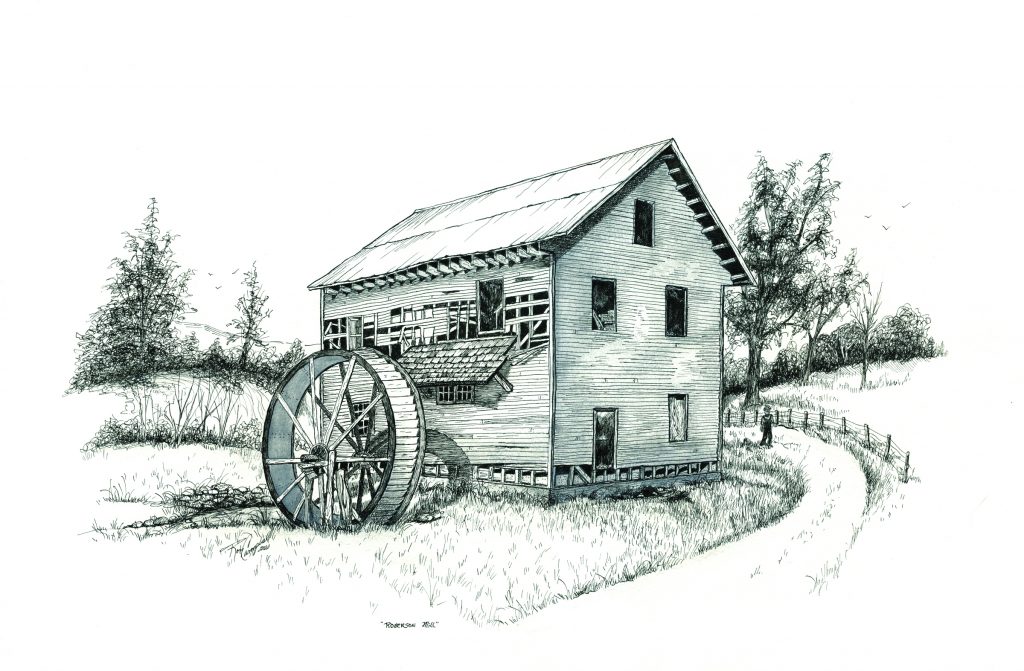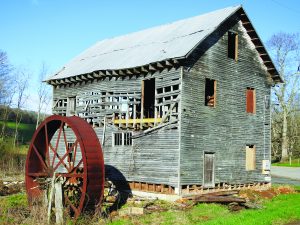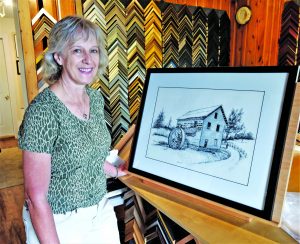
by Ron Campbell
When artists create images on canvas or paper or whatever medium is chosen, they are in fact recording a piece of history. Whether it be a landscape, an old barn, or a portrait, the image becomes a record of that day, or that time, or even the feeling that existed at that moment. When it is placed on a wall somewhere, the art then becomes a document of historical importance, waiting to tell someone in the future about an event that happened in the past.
Now, travel with me to the present, it’s a short trip. Because there’s no time like the present to learn a little about the past. And together, we just might be able to catch a glimpse of the not-so-distant future of a remarkable 140+ – year old, Floyd landmark. Throughout the years, the subjects of my art have often been old barns, buildings, or just scenes from abandoned homesteads. When drawing these, I try to put myself in the shoes or boots of those who struggled to cut the lumber and nail the boards; sometimes in the hot summer heat, or maybe even while shivering in the cold winds of winter. I always appreciate their efforts, even though I seldom learn their names.
 The exception, however, is a historic building with which I recently became acquainted. It once served not only the town of Floyd, but also many more neighboring southwest Virginia counties, reaching as far south as North Carolina.
The exception, however, is a historic building with which I recently became acquainted. It once served not only the town of Floyd, but also many more neighboring southwest Virginia counties, reaching as far south as North Carolina.
The history of Roberson Mill is well documented, so unlike many things I have drawn, I can take delight in sharing a small portion of the tale of those who labored to build and run it.
Sometime in January of this year (pre-Covid19), I happened to view a post on Facebook announcing two fundraisers planned for the purpose of raising money to restore this very old, water powered mill.
It was built in the 1880’s by John Epperly. This was the same John Epperly who later built Epperly’s Mill on Epperly Mill Road in Floyd; also a county landmark. That first mill John built, however, would be purchased in 1931 by Homer Roberson, who owned and operated it until his death. Though Homer passed the mill to his five children, it was eventually purchased by his son, Harry Roberson, who ran it until 1984. I followed the link from the Facebook post to the full article on Roanoke.com.
 Here, I not only read about the mill’s history, but also stumbled upon an interesting story about the mission of a lady named Regina Cox. Regina is not only a native of Floyd, but also the daughter of Harry Roberson. Her father recently deeded her the acreage, along with the mill, which currently sits decaying by the creek on Roberson Mill Road. Wanting to keep the rain out, and also wanting to keep the mill from falling into the road, Regina set her sights on reversing this decay.
Here, I not only read about the mill’s history, but also stumbled upon an interesting story about the mission of a lady named Regina Cox. Regina is not only a native of Floyd, but also the daughter of Harry Roberson. Her father recently deeded her the acreage, along with the mill, which currently sits decaying by the creek on Roberson Mill Road. Wanting to keep the rain out, and also wanting to keep the mill from falling into the road, Regina set her sights on reversing this decay.
Regina assumed the mantle and lead responsibilities. With the help of her cousin, Angie Parvin, as well as many siblings, the group set out to raise money for the restoration of a building that was not only part of Roberson family history, but also a significant feature in the history of Floyd County. Unfortunately, Regina’s vision had to grow when problems presented themselves. Costs continued to increase as the project was constantly reassessed. Simple things became not so simple. What was simple, however, were the times Regina spent growing up with her siblings.
She fondly remembers how they, as children, were allowed to help at the mill, filling and bagging cornmeal and buckwheat flour for the people of Floyd and surrounding areas. The buckwheat flour especially was a staple much desired by the mill’s customers. Driven by beautiful memories of long ago, Regina became determined to restore the old mill. She hoped to make it functional again, so it could someday educate younger generations about their early heritage, or perhaps bring back some memories for those seniors who might one day revisit the landmark.
Regina’s childhood memories, however, were not the only source of spirit for this project. It was also the final dream of Regina’s brother, Timmy. Even while fighting a losing battle with cancer, Timmy sketched and formulated plans that would help raise money to restore Roberson Mill. After all, it was a place where he, too, had many childhood memories. Unfortunately, it was a wish that he would not live to see come true. Timmy succumbed to his illness and passed away in December of 2019.
To Regina, the restoration project became a calling, and she vowed to deliver her brother’s final wish “to Timmy, now in his heavenly home”. Seeing pictures of the mill in its current state, I found myself thinking that this would be a great subject for my pen  and inks. If the drawing could capture the spirit of the mill, I could donate it to help raise money. I could also donate further to the cause by a pledging a portion of the sales of the prints. I presented the offer to Regina and she liked it.
and inks. If the drawing could capture the spirit of the mill, I could donate it to help raise money. I could also donate further to the cause by a pledging a portion of the sales of the prints. I presented the offer to Regina and she liked it.
We then visited the mill to take a series of pictures that would guide me to the finished product.
As I sketched from the pictures I had taken, I thought of how amazing it was that the power of water, flowing freely beside this building, harnessed by a man named John Epperly over 140 years ago, could turn and rotate the mill stones inside. Even more wonderous, with the hard work and determination of the Roberson family, how those stones could turn wheat into flour. Then flour could become a warm, fresh loaf of bread on a table, served with butter churned from cream given by a cow, possibly named Gertie.
 I rode by the mill today (August 25th) and all four sides have been closed to the weather. There is much left to be done before Roberson Mill and its historical value can be appreciated by the public. Most of the parts and pieces remain.
I rode by the mill today (August 25th) and all four sides have been closed to the weather. There is much left to be done before Roberson Mill and its historical value can be appreciated by the public. Most of the parts and pieces remain.
Regina continues to search for and secure funds. You can help in this effort, if you wish, by visiting www.RobersonMill.com and donating to the project. The artwork is finished now and is safely behind frame and glass. It will hang at the Maggie Gallery until it finds its new home. The funds received will be passed on to the Roberson Mill Restoration Project. In its new home, it will become a piece of historical information for someone in the future to learn about something that happened in the past, in a little mountain town called Floyd.
Tax deductible donations for the Roberson Mill Restoration Project can be forwarded to: Floyd County Cares 100 E. Main Street – Room 206 Floyd, Virginia 23491
